It is difficult to imagine life in our world without information technologies such as the Internet, television and telephone. They are firmly rooted in society and are an important attribute of comfort. However, not all users know how to connect to digital TV at home, so they often have certain difficulties when setting up the device.
general information
Recently, there has been an increase in the popularity of digital television. In contrast to traditional analogue systems, this type of TV has a lot of significant advantages, providing maximum picture and sound quality.
And when it comes to connecting "digital" to a TV, many people think that this is a very difficult process that requires professional help. But in reality, everything is decided in a short time and does not require much effort. It should be noted, that there are two types of digital TV on the market:
- Cable.
- Essential.
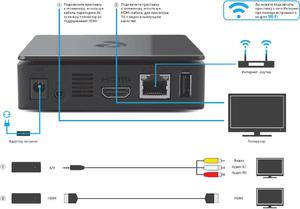 The first type is connected via a special television cable, and the second implies the presence of a special antenna. When the TV does not have a digital receiver, you will have to buy it additionally. In stores, these devices are sold as a special attachment.
The first type is connected via a special television cable, and the second implies the presence of a special antenna. When the TV does not have a digital receiver, you will have to buy it additionally. In stores, these devices are sold as a special attachment.
If your home TV is already equipped with a digital receiver, then all that is required for work is to install a digital TV smart card with connected provider services. The device will then automatically search for the channel list and store them in memory.
If you don't have a receiver, you need to buy a set-top box. It is very good if your TV has an HDMI output, as it carries the best picture and sound.
Benefits of modern systems
Despite the development of digital TV systems, many people still use cable television. It also gives a good picture and unlimited possibilities in the choice of channels. However, for such TV you have to pay a subscription fee, which, unfortunately, is constantly growing. As for digital equipment, then it has the following advantages:
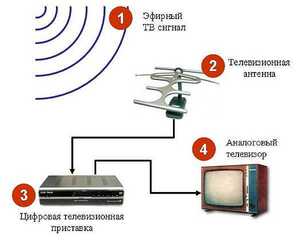
Receiver selection
 To successfully launch digital television in a private house, you need to buy a special device - a digital signal receiver. In its capacity, a device operating according to the DVB-T2 standard is used. As already mentioned, many modern TV models are already equipped with a built-in digital TV module, so the task can be significantly simplified.
To successfully launch digital television in a private house, you need to buy a special device - a digital signal receiver. In its capacity, a device operating according to the DVB-T2 standard is used. As already mentioned, many modern TV models are already equipped with a built-in digital TV module, so the task can be significantly simplified.
The capabilities of the device are determined by its price range. The most affordable receivers do not support additional functions, while the more expensive devices have less memory and are capable of working with flash drives. Also, some models have the ability to record streaming video to removable media.
Given the wide variety of digital receivers, choosing the right option can be problematic. But if you are guided by some tips and tricks, such a task can be solved without much difficulty.
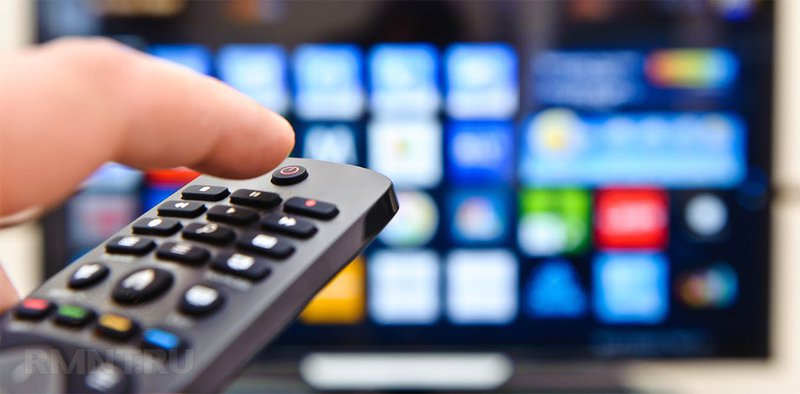
If we ignore the technical aspects and complex radio-mechanical properties of the digital tuner models available on the market, then it remains to study their aesthetic features and a set of functions. This approach will simplify the selection of a quality device and make it successful.
When wanting to purchase a digital receiver, it is important to decide in advance what functions are needed for television, and what you can refuse. The most key and necessary functions include:
- The ability to view TV channels in DVB-T2 format.
- The ability to use the tuner as a media player to run audio files, view images and other content.
- Access to the global network (some models are capable of working with YouTube media services, IPTV, online cinemas, weather and news resources, etc.).
If the receiver model supports the above functions, it remains to deal with some visual features. When choosing a case material, it is advisable to give preference to devices made of high-quality metal or plastic. These materials are known to offer maximum reliability and long service life.
The front panel of the tuner should contain control buttons, as well as various indicator lights. There should be USB inputs and other high-tech interfaces at the back.
Buying an antenna
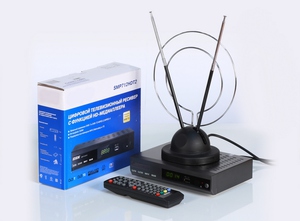
For DVB-T2 receivers, conventional terrestrial antennas capable of operating in the UHF range are suitable. In this regard, many viewers believe that there is no need to buy a special antenna, stopping only at buying a set-top box. But this is a huge misconception, because old equipment cannot produce a sufficiently high-quality signal and convert an analogue channel into a digital one. The digital stream is broadcast in parallel with the analog stream at completely different frequencies.
There is another myth that says that powerful digital set-top boxes can transmit images without an antenna at all. But in practice this is impossible, although with good coverage, it is enough to install a small piece of wire in the antenna input for the TV to start receiving a signal. But such cases are rare.
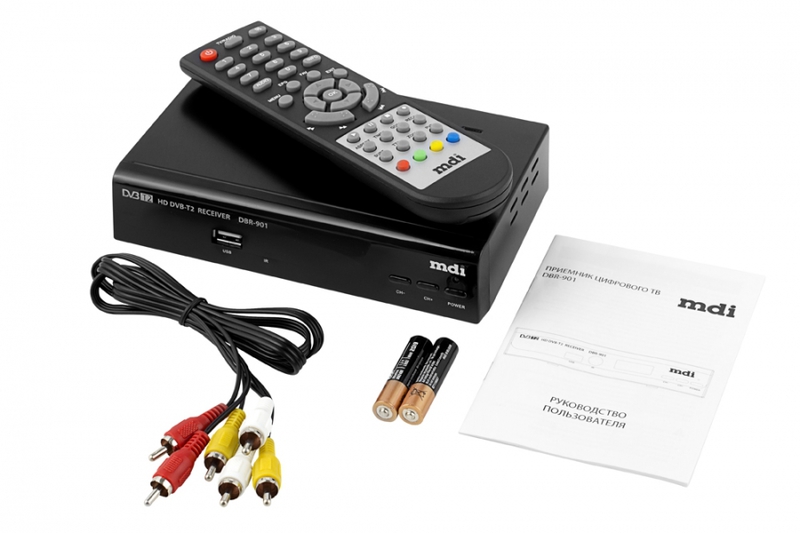
If the house already has an over-the-air antenna, but it does not transmit the image, then it is necessary to perform several actions and diagnose the equipment. In the absence of such a device, it is better to buy a more powerful model for digital TV.
It should also be noted that outdoor antennas are always more powerful than indoor antennas, even if the latter are equipped with advanced receivers and amplifiers. Unfortunately, many TV viewers buy compact models at online electronics stores, although a good outdoor option can be purchased for the same price.
As for indoor antennas, they can only be effective if the television tower is located within the village. At a significant distance from the city, such equipment will be ineffective and even useless. For such conditions, you will have to buy an external antenna. Before buying, you should study in detail the digital signal coverage map to determine where the nearest broadcasting points are located.
Additional elements
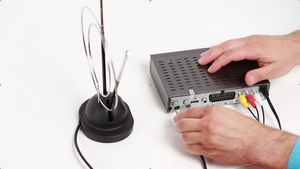 Also, for the successful operation of digital television, you need to buy several additional items. Among them is an amplifier. Many indoor and outdoor antennas already have this device, and the receiver only amplifies the signal. In this case, the transfer of information occurs confidently and without interruptions.
Also, for the successful operation of digital television, you need to buy several additional items. Among them is an amplifier. Many indoor and outdoor antennas already have this device, and the receiver only amplifies the signal. In this case, the transfer of information occurs confidently and without interruptions.
However, you often have to buy a separate amplifier. To make sure whether you need it or not, it is enough to check the signal quality with the DVB-T2 receiver by entering the system settings with the appropriate scale. If, after connecting the antenna to the receiver, the signal level is 75%, and the picture quality is quite normal, then the amplifier may not be needed. If the indicators do not reach this mark, and the image is transmitted with significant interference, the purchase of an amplifier will become a prerequisite.
Also, to connect digital TV, you need to purchase a coaxial cable that is capable of transmitting the signal from the antenna directly to the receiver. It is advisable to give preference to models with a copper circuit and a screen, since they are characterized by high image quality, long service life and reliability. When choosing a cable, you should pay attention to its braid, because the stronger it is, the longer it will last.
If your receiver has an HDMI connector, you need to purchase an appropriate cable to connect to your TV. Experts say that this standard guarantees the best quality picture and sound transmission. If HDMI is not available, you will have to use traditional SCART, RCA, etc. cables.
Installation of devices
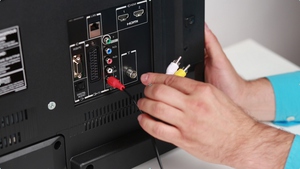 When installing a digital television system, you must first install the antenna. If a room model is used, then it must be placed near the window, since there is the best signal level. As for the external elements, they are installed on the balcony or near the window using brackets.
When installing a digital television system, you must first install the antenna. If a room model is used, then it must be placed near the window, since there is the best signal level. As for the external elements, they are installed on the balcony or near the window using brackets.
The antenna equipment is directed towards the location of the TV tower, which will have a positive effect on the quality of reception. Then you need to lay the cable from the antenna to the receiver. In the absence of a stable signal, the antenna is placed on the roof of the house and turned towards the TV tower. To correctly determine where the television tower is located, it is enough to look where the adjacent antennas are directed.
Next, you need to unpack the receiver and connect the antenna cable to it. After turning on the receiver's power, you need to make some initial settings by selecting the appropriate language, time and time zone. With the support of the automatic channel scan function, there will be no special difficulties in setting up. The system will do everything on its own.
At the setup stage, you need to find the channel of the first multiplex and scan it, and then repeat the same steps with the second device. According to experts, there are about 10 channels in each of these multiplexes. During the procedure, you should pay attention to the signal level. It will be displayed in the settings menu as a special scale. If the reception level is too weak, it is necessary to twist the antenna and find the optimal direction, guided by the data from the scale.
Setting up digital television
How to connect digital TV is a relevant topic for modern TV viewers, because after purchasing the appropriate devices, many users do not know how to set them up correctly. To quickly solve the problem, you need to follow the step-by-step guide:
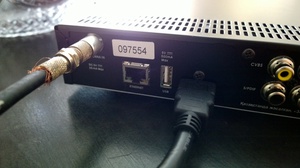
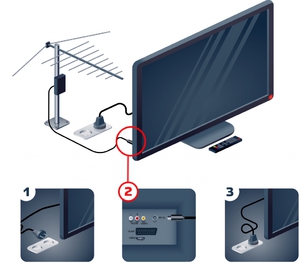 It should be noted that over time, the list of available channels may be updated, so it is necessary to periodically re-scan in search of updates. If you encounter any unexpected problems at the stage of tuning the tuner, you should study the instructions again. If the problem persists, then you should contact your equipment and service provider for help.
It should be noted that over time, the list of available channels may be updated, so it is necessary to periodically re-scan in search of updates. If you encounter any unexpected problems at the stage of tuning the tuner, you should study the instructions again. If the problem persists, then you should contact your equipment and service provider for help.
It's easy to figure out how to connect free digital TV to your TV. To do this, just follow the step-by-step instructions that come with the receiver, follow the advice of professionals and be careful. The system will do the rest on its own.